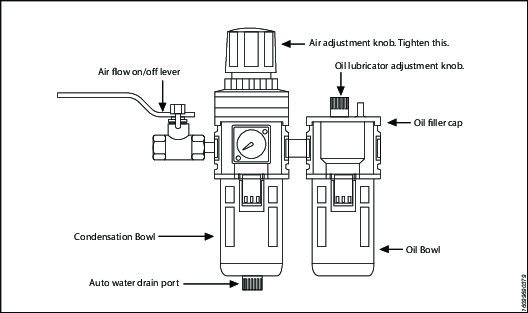RTX-04
Hydraulic Torque Wrench
製品情報
一般情報
安全信号用語
安全信号用語の「危険」、「警告」、「注意」、「通知」には次のような意味があります:
危険 | 「危険」は、回避しなければ、死亡または重傷を負うことになる危険な状況を示します。 |
警告 | 「警告」は、回避しなければ、死亡または重傷を負う可能性のある危険な状況を示します。 |
注意 | 「注意」は安全警戒記号とともに用いられ、回避しなければ、軽傷または中程度の傷害を負う可能性のある危険な状況を示します。 |
通知 | 「通知」はケガに関係しない手順に対して用います。 |
保証
製品保証は、製品を最初に使用してから 12 か月で有効期限が切れますが、いかなる場合でも納品後、最長 13 か月で有効期限が切れます。
部品の通常の磨耗や傷は保証に含まれません。
通常の摩耗および裂傷は、その期間に典型的な標準的な工具のメンテナンス(時間、稼働時間などで表される)中に部品交換またはその他の調整/オーバーホールが必要なものです。
製品保証は、ツールとその構成部品の正しい使用、メンテナンスおよび修理に依存しています。
不適切なメンテナンス、または、保証期間中に Atlas Copco以外の人またはその認証サービスパートナーによって実施されたメンテナンスの結果発生した部品の損傷は保証対象となりません。
ツール部品の損傷や破壊を防ぐために、推奨されるメンテナンススケジュールに従ってツールの整備を行い、適切な手順に従ってください。
保証による修理は、必ず Atlas Copcoワークショップで、または認定サービスパートナーが実施してください。
その Atlas Copco契約により、延長保証と最新式の予防保守を提供します。ToolCover詳細については、お近くのサービス担当者にお問い合わせください。
電動モータの場合 :
電動モータが開かれていない場合のみ保証が適用されます。
ウェブサイト
当社の製品、付属品、スペアパーツおよび公表事項に関する情報は、Atlas CopcoのWebサイトにてご覧いただけます。
次をご覧ください:www.atlascopco.com.
ServAid
ServAidは以下のような技術情報を含むポータルで、継続的に更新されます:
規制及び安全に関する情報
技術データ
設置、運転およびサービスに関する注意事項
予備部品のリスト
アクセサリ
寸法図面
次をご覧ください:https://servaid.atlascopco.com.
詳細な技術情報については、最寄のAtlas Copco代理店までお問い合わせください。
安全データシート MSDS/SDS
安全性データシートは、Atlas Copcoが販売する化学製品について説明しています。
詳細についてはAtlas Copcoのウェブサイト www.atlascopco.com/sdsをご覧ください。
生産国
生産国については製品ラベルの情報をご参照ください。
寸法図面
寸法図は、寸法図アーカイブまたはServAidのいずれかにあります。
次をご覧ください:http://webbox.atlascopco.com/webbox/dimdrwあるいは https://servaid.atlascopco.com。
概要
技術製品データ
技術的な製品データは、ServAidまたはAtlas Copcoのウェブサイトにあります。
次をご覧ください:https://servaid.atlascopco.comあるいは www.atlascopco.com。
サービスの概要
サービスの推奨事項
予防メンテナンスを定期的に行うことをお勧めします。予防メンテナンスに関する詳細情報を参照してください。製品が正常に動作しない場合は、供用を停止して点検してください。
予防メンテナンスについての詳細な情報がない場合は、これらの一般的なガイドラインに従ってください。
適切な部品を正確に清掃します
不良部品や磨耗した部品を交換します
操作
人間工学に関するガイドライン
一般的な人間工学に基づいたガイドラインの本リストを読み、姿勢、コンポーネントの配置、作業環境において改善できるエリアを特定して、ご自身のワークステーションについてご検討ください。
頻繁に休憩をとり作業姿勢を変更すること。
ワークステーション領域を任意のニーズと作業タスクに適合させること。
静止荷重を避けるために部品やツールがどこに配置されるべきかを決定することにより、適度に手の届く範囲を調整すること。
テーブルや椅子などの作業タスクに適切なワークステーション設備を使用すること。
組立操作中に肩より高い位置または静止保存状態での作業を避けること。
肩より高い位置で作業する場合、トルクアーム、ホースリール、または重量バランサーなどを使用してツールの重量を減少させることにより静的筋の負荷を軽減すること。静的筋への負荷はツールを体に近づけて保持することによって軽減することもできます。また、負荷を身体の近くに保持することで静的筋肉への負荷を軽減することができます。
頻繁に休憩を取ること。
とりわけ、ある程度の力を要する作業において、腕または手首の無理のある姿勢を避けること。
必要とする目と頭の動きを最小限にするよう、視野を便利なように調整します。
作業タスクに適切な照明を使用すること。
作業タスクに適切なツールを選択すること。
騒音の多い環境では、防音保護具を使用してください。
過剰な振動レベルへの曝露を最小限にするには、高品質の挿入ツールおよび消耗品を使用してください。
操作手順
作動圧力
The tool's maximum working pressure is 10,000 psi (700 bar). Make sure that all hydraulic equipment (pumps, hoses, couplers) used with this tool are rated for 10,000 psi (700 bar) working pressure. Review the documentation for the hydraulic pump in use to ensure pressure does not exceed 10,000 psi.
Electric Connections
Ensure proper power availability to prevent motor failure or dangerous electrical overloading. Use the recommended amperage listed on the motor nameplate. Do not use electric pump if ground is not connected on plug.
延長コードの長さを最小限にし、それらが適切なワイヤサイズで接地されていることを確認してください。
Extension cord should be #10 AWG gauge.
エア接続
Ensure that you have sufficient air flow (58 up to 100 PSI / 4 up to 7 bar) to operate you pneumatic pump. If in doubt, compare the pump manufacturer's recommended air flow rating prior to pressurizing pump. Improper air flow may damage the pump motor.

For best results use air hoses equal or larger than 3/4” internal diameter.
Use of a F.R.L. (Filter Regulator Lubricator) is highly recommended. Fill with oil and adjust the air admission with the adjustment knob.
Hydraulic Connections
Our hydraulic pumps are equipped with a zero-pressure relief valve. However, it could be possible that the retract side remain pressurized after the pump has been switched “off”. This trapped pressure prevents the user from loosening the retract-side fittings by hand. To release the pressure, simply push the black button on top of the solenoid. All fittings are free to be manually tightened.
Never disconnect or connect any hydraulic hoses or fittings without first unloading the wrench and the pump. If the system includes a gauge, double check the gauge to assure pressure has been released. When making connections with quick disconnect couplings, make sure the couplings are fully engaged. 継手やゲージなどのネジ接続部は、クリーンでしっかり締められており、漏れがない状態でなければなりません。
General Setup
All our hydraulic torque wrenches are supplied completely assembled, ready for use. An Atlas Copco hydraulic power pack, for use with your Atlas Copco hydraulic torque wrench, is recommended to provide the speed, pressure and portability that make your Atlas Copco System efficient and accurate.
The accuracy of your Atlas Copco hydraulic torque wrench is +/-3% based upon our manufacturer's specifications. This accuracy is certified through calibration tests conducted by Atlas Copco or any other qualified calibration facility whose program is traceable to the National Institute of Standards and Technology (N.I.S.T). We strongly suggest using Atlas Copco certified gauges (with a class 1 accuracy) to enhance the accuracy your torquing system.
サービス
メンテナンスに関する注意事項
サービスとメンテナンスに関する推奨事項
ツールの操作、修理、保守の際、あるいはツールのアクセサリを交換する際、または、その近くにいる場合、必ず目と顔を守る耐衝撃性防具を着用してください。
調査、保守、修理作業はすべて、システム全体の圧力がゼロの場合にのみ実行してください。
最適な性能を得るために、ツール、パワーパック、ホース、コネクタ、電線ケーブルやアクセサリに視覚的な損傷がないか頻繁に検査してください。ツールおよびポンプのメンテナンスに関する指示に、常に従ってください。
サービス間隔に関するガイダンス
訓練を受けた人員が適切なメンテナンススケジュールを守った場合、油圧レンチは長年にわたって問題なく使用できます。ただし、ツールはすべて、長期間使用すると摩耗します。ツールの寿命に影響する要因:
高サイクル速度
高負荷使用
衝撃
汚れた、高温または湿気の多い環境での動作
さまざまな反力方法
メンテナンス不良
レンチが正常に作動するように、定期的に注油とオーバーホールを行うことをお勧めします。高トルクや高サイクル速度、長時間の締め付けを行う場合には、より頻繁にサービス間隔が必要になることがあります。レンチが正しく作動しない場合には、ただちに点検に出してください。
以下のサービス間隔はあくまでも目安です。ユースケースやアプリケーションはそれぞれ異なるため、作業環境や使用度に合わせて適切な計画メンテナンスを実施するのはエンドユーザーの責任となります。ツールの使用記録を保管してください。この記録は、ツールやコンポーネントのサービス、校正、交換の計画に役立ちます。
ライトデューティー
例:低圧でのまれな定格荷重の 40% 未満での使用。
潤滑:6 か月毎
オーバーホール:12ヶ月毎
ノーマルデューティ
例:定期的な、定格荷重の 80% 未満での使用。
潤滑:3 か月毎
オーバーホール:ドライブピンの交換を含め、12 か月毎。セクション 潤滑 を参照してください。
ヘビーデューティー
例:継続的なあらゆる圧力で、定格荷重の 80% 超での使用。腐食したボルトを緩めるのに定期的に使用。
潤滑:1 か月毎
オーバーホール:ドライブピンとドライブの爪交換を含め、6 か月毎。セクション 潤滑 を参照してください。
ツール交換
製品所有者は、ツール交換ポリシーに基づいたサービス計画を策定・実行する必要があります。このポリシーにより、ツールが使用できなくなる前に稼働しているツールが交換されることが保証されます。多様な動作環境が想定され、ツールの保守メンテナンスが一様でない可能性があるため、ツールの寿命を定義することは困難です。
傷跡、へこみ、材料の欠損などの視覚的な摩耗の兆候が見られる場合は、ツールがもはや有用ではないことを示します。摩耗の兆候が見られるツールは、保守サービスしてください。ツールの状態を維持するために、損傷した部品をすべて交換してください。もしツールに圧力保持部品や反力アームへの大きな損傷が見られる場合、安全上の理由からそのツールを直ちに取り除くのが正しい処置です。
詳細については、「サービス間隔に関するガイダンス」を参照してください。
予防メンテナンス
油圧トルクレンチシステムを良好な状態に保つために、使用期間ごとに次のメンテナンス手順を実行してください。
外側の表面をすべて拭き取り、ツールに損傷の兆候がないか目視検査します。必要に応じて調査します。
すべての油圧継手と接続部に油圧漏れの兆候がないか調べます。必要に応じて調査します。
すべての油圧カップリングが清潔で、破片がないことを確認してください。
ホースの全長にわたって検査します。切り傷や擦り傷がないか調べます。スエージ加工された端に細心の注意を払い、漏れの兆候がないか探します。
機器が正常に機能している場合は、Shell Ensis や Castrol Rustillo などの適切な防錆油をスプレーし、次回の使用に備えて保管します。
オーバーホールの手順
レンチをポンプに接続します。
すべてのメカニズムが期待どおりに機能することを確認する圧力テストを実施します。
誤動作や油圧漏れがないか調べます。
システムを減圧し、すべてのカップリングを外します。
レンチを分解します。
すべてのシールとスプリングを交換します。
ドライブピンを交換します。
損傷や摩耗の兆候が見られるその他のコンポーネントをすべて交換します。
レンチを再潤滑して再び組み立て直します。
圧力テストを実施して、すべてのメカニズムが期待どおりに機能することを確認します。
レンチを校正して、トルク出力が期待どおりであることを確認します。
潤滑手順
潤滑油ガイド
ドライブコンポーネント | Molykote 1000 |
シール | Rocol Sapphire Aqua-Sil |
ファスナー | Loctite 243 |
テーパー油圧ねじ | Loctite 577 |
潤滑
レンチを良好な状態に保つには、サービス間隔の合間にドライブコンポーネントに定期的に注油してください。
潤滑前の分解:
サイドプレートのねじとサイドプレート [1] を取り外します。
ドライブアセンブリ [2] を取り外します。

潤滑メンテナンス中は、次を行います:
ドライブピンとスプリングに摩耗や損傷の兆候がないか調べます。必要に応じてドライブピンとスプリングを交換してください。
ラチェットの歯先に損傷の兆候がないか調べます。必要に応じてラチェットを交換してください。
ドライブの爪の歯に損傷の兆候がないか調べます。必要に応じてドライブの爪を交換してください。
ドライブの爪のスプリングに破損の兆候がないか調べます。必要に応じてスプリングを交換してください。
網掛け部分に潤滑剤 Molykote 1000 を塗ります。
組み立ての手順は分解の手順と同じですが逆になります。
トラブルシューティング
Troubleshooting Powerpacks
Atlas Copco Hydraulic Power Packs are precision-built units and, as such, do require a certain amount of care and maintenance
Hydraulic Oil should be completely changed after every 300 hours of operation, or at least twice a year. Always make sure the reservoir is filled with fluid. Always use Atlas Copco Maximizer range of oils for best performance.
Couplers and fittings should be checked periodically for leaks. Dirt or foreign materials should be kept away from fittings. Clean before use.
Hydraulic Gauge: Some gauges are liquid filled. Should this liquid level drop, it indicates external leakage, and replacement is necessary. Should the gauge fill with hydraulic oil, it indicates internal failure and it should be discarded.
Filter on Pump: The filter should be replaced twice a year in normal use and more often if the pump is used daily or in a dirty, harsh environment.
リモート コントロール (Air Unit) The airline to the remote control unit should be checked for obstructions or kinks in the line periodically. If there is a bend or break in the line, it must be replaced. The spring- loaded buttons on the remote handle should be checked in the event of operating difficulties. (Electric Unit) The switch buttons should be checked periodically if any indications of problems exist.
Air Valve: This valve should be checked twice a year.
Armature: (Electric Unit) Check yearly.
Pumping unit: The pump should be overhauled every 2 years. This can be done by Atlas Copco or by a qualified hydraulic service centre.
Troubleshooting Routines
Test 1
Attach hoses to pump and tool in the normal manner.
Press the advance button and hold it down.

If the pump pressure builds and the hoses "flex" but the tool still refuses to cycle, the problem is most likely a loose or defective coupling connection. To find out where the bad coupling is, remove the tool from the hoses and marry the loose ends together and cycle the pump. If the gauge pressure reads no more than 500 PSI, then the bad fitting is on the tool. A significantly greater pressure indicates that the problem is in either the pump or a hose fitting.
Test 2
Remove screws from pump motor to reservoir, slide pump motor to the back while keeping pistons into oil.
Turn pump on. If you have no oil coming out from the solenoid tube, change the solenoid.
Tight the regulating valve to maximum, Push on the advance button and while holding down, look if any oil is coming out from the regulating tube. If oil is coming out, change the regulating valve.
Test 3
Remove tool from hoses.
Cycle pump.

If pump fails to build pressure, the problem is with the pump. If it does build pressure, the problem is with hydraulic blow-by in the tool.
Test 4
This test should be run prior to every use of an Atlas Copco Tool
Connect the tool, pump and hoses together as normal.
Cycle the pump several times.
Cycle the system once more and observe the sequence of operation.
As you depress the advance button, the tool drive shroud turn about 24 degrees and you should hear an audible "click". You will also notice that the disengagement levers will move to the rear of the tool and spring forward.
At this point, release the advance button. You should see no further movement and after a moment you will hear another audible "click". This is how the tools are designed to operate.
If you observe any other sequence of operation, the system is out of order and cannot deliver more than 10% of its designed capacity.
Take immediate corrective action. For reference, tools and pumps are designed from the factory plumbed as follows. This ensures that the tool, pump and ONE hose cannot possible be connected up incorrectly.
Test 5
Tool | ホース | ポンプ |
|---|---|---|
Advanced Side-Male | Advance side- Female to Female | Advance side-Male |
Retract side-Female | Retract Side-Male to Male | Retract Side-Female |
Note that connecting two (or any even numbers) of hoses together creates "one" hose which is plumbed backwards! Male to Female and Female to Male. This will cause the system to operate backwards per Test #5 above. If you hose isn’t long enough, connect 3 hoses together, move your pump or call Atlas Copco for a longer hose assembly.